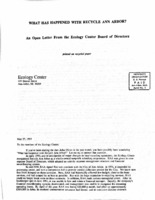Revitalizing Recycle Ann Arbor
"What happened to Recycle Ann Arbor?" Open Letter from the Ecology Center Board of Directors, May 27 1992.
Meeting New Demands
In 1990, recycling in Ann Arbor scored several major victories in areas of policy, community participation, and city recognition. First proposed in 1988, in November 1990 the Mandatory Recycling Ordinance received a unanimous vote from city council and offered an even more comprehensive approach to city-wide recycling than the initial proposal.
Anticipating the need for financial support, in April 1990 the city had approved a $28 million "Environmental Bond" package designed to modernize Recycle Ann Arbor and fund numerous other solid waste management initiatives, including the expansion of the city’s landfill. The recycling ordinance and bond measure, however, would prove to be a blessing and a curse for Recycle Ann Arbor. The organization's struggles to meet the new demands of city-wide recycling pushed RAA to near-bankruptcy and required serious inquiries into the financial operations and internal leadership of RAA.
RAA Seeks More Autonomy from the Ecology Center
Toward the end of the 1980s, Recycle Ann Arbor was beginning to feel growing pains resulting from their 1982 merger with the Ecology Center. Although RAA was largely independent in terms of its operations, the EC had complete financial control. According to a letter from the RAA staff to the EC board of directors, RAA was frustrated by not knowing how their money was being spent:
"Recycle Ann Arbor must be responsible for keeping its own books, managing its own accounts payable and receivable, and for educating the public at large about the need for, and nature of, the services we provide. To do this we must have the legal authority to manage our finances ourselves, or hire the appropriate services that accommodate our needs without the constraints of past practice or assumed obligations.”
RAA asked to be restructured as an affiliated, wholly-owned, non-profit subsidiary of the Ecology Center. This structure that the two groups settled on transferred financial management over to RAA, and enabled RAA to hire specialists in recycling and service delivery systems. RAA’s board of directors and other major decisions would still have to be approved by the EC’s board of directors, but otherwise, the two organizations would enjoy a larger degree of autonomy.
The Environmental Bond of 1990
Just as the EC granted RAA its subsidiary status, the Environmental Bond proposal passed by a landslide in April, 1990. Suddenly, RAA became the city's premier recycling service provider thanks to new funding allocations from the city and its promise to build a Materials Recovery Facility (MRF) to streamline source separation. Within a year, RAA switched from monthly to weekly curbside pickup; distributed new collection totes to single- and multi-family houses; upgraded collection equipment with a new fleet of trucks; and renovated the materials processing facility.
Prior to 1990, RAA had collected about 3-4% of recyclables throughout Ann Arbor. Residents needed to carefully separate all of the different materials and remember to set them out on their neighborhood's designated collection day. With the introduction of mandatory recycling and weekly curbside recycling in 1990, and the promise of the MRF opening by 1993, collection totals jumped to 30%. At the same time, to manage the expansion, RAA’s staff tripled. The combination of unprecedented growth and adjusting to new internal financial and managerial structures meant the results of the Environmental Bond were both a blessing and a curse.
Back from the Brink: Saving RAA in 1992
Such rapid changes to RAA's scope and scale proved to be unsustainable. By early 1992, the organization faced bankruptcy. It simply could not keep up with the financial demands of the new services promised by the Environmental Bond and recycling ordinance. In May 1992, Charles Barbieri, the president of the EC Board of Directors, composed an open letter to EC members explaining the situation. In addition to financial challenges, RAA faced a turnover of staff with several bookkeepers and financial manager unable to solve the financial crisis. By April 1992, RAA was $300,000 in debt and losing about $20,000 per month.
At this point, the Ecology Center and the city of Ann Arbor both intervened. Mike Garfield, then the co-director of the EC, was named interim director of RAA and oversaw several changes in staff and structure during the summer of 1992. Once RAA’s leadership was in place the city also authorized a bailout package. Mike Garfield recalls the situation in an interview from July 22, 2019:
"I had been sent down to RAA to try to fix things up when they got into some disrepair. And we spent most of ten, eleven, twelve months in 1992 and 1993 getting RAA back on its feet and getting the structure put in place the way it was meant to be put in place ... The city was very supportive at the time, the community was very supportive of RAA at the time, but it was tense.”
RAA’s stability was resolved almost as quickly as it had unraveled. With the benefits of Garfield’s leadership, new financial and operations managers came in to administer finances and develop a sustainable scheme for managing the new quantity of recycled materials at the processing facility. RAA owed much to the city’s understanding and patience as well. By October, 1992, RAA had renegotiated its contract and settled debts with creditors. Back on its feet the organization was ready to continue providing comprehensive recycling services throughout Ann Arbor.




